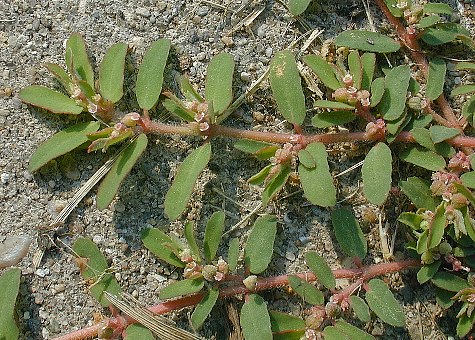Description: This plant is a summer annual that branches frequently at the base, forming a spreading mat against barren ground that is about 6-18" across, but usually less than 1" tall. However, when other vegetation is present, the stems may ascend to 6" in height. The slender round stems are more or less covered with hairs, and often turn pale red in the presence of bright sunlight. The opposite leaves are up to ¾" long and ¼" across, but they are usually smaller in size. They are oblong in shape, smooth or slightly toothed along the margins, and have short petioles. Each leaf is more or less oblique at the base (i.e., asymmetrical where the petiole joins the leaf blade), and it often has a red blotch near the middle of the upper surface. Both the stems and the major veins of the leaves contain a milky juice.

From the axils of
the leaves, there often appears either a single flower or, more
commonly, a small leafy cluster of flowers. Like other Chamaesyce
spp. (Ground Spurges), Prostrate Spurge is usually
monoecious, each plant having separate male and female flowers. Less
commonly, a plant may be unisexual, producing either all male flower or
all female flowers, but not both. Each male or female flower is less
than 1/8" across, and consists of a small floral bract in the shape of
a cup, which contains 4 glands with petal-like extensions along its
upper edge. These petal-like structures are either white or light red
and quite small. Each cup-shaped bract has a slit on one side that is
1/4–1/3 as long as the bract. Each female flower has a 3-valved seed
capsule that is hairy and hangs along the side of the bract from a
stout pedicel. Each valve of the capsule contains a single 4-angled
seed that is minutely pitted and has faint transverse ridges across its
surface. The seeds are hydrophilic and can adhere to surfaces when they
are wet. Each male flower has 4 stamens with yellow anthers that extend
beyond the rim of the cup-shaped bract. Neither female nor male flowers
have any petals or sepals. The blooming period occurs from mid-summer
through the fall and lasts about 2 months for individual plants. There
is no noticeable floral scent. The root system consists of a slender
taproot. This plant spreads by reseeding itself.
 Cultivation:
The preference is full sun, dry conditions, and open barren ground that
is sandy, gravelly, or rocky (including cracks in pavement). The Ground
Spurges develop slowly, and don't become conspicuous until late summer.
Cultivation:
The preference is full sun, dry conditions, and open barren ground that
is sandy, gravelly, or rocky (including cracks in pavement). The Ground
Spurges develop slowly, and don't become conspicuous until late summer.
Range & Habitat:
The native Prostrate Spurge is a common plant that occurs in every
county of
Illinois. Habitats include glades, dry sand prairies, cropland,
gravelly areas along railroads and roadsides, lawns and gardens, cracks
in sidewalks and pavement, borders along buildings, and sterile waste
areas containing sand, gravel, or compacted soil. This plant prefers
disturbed areas, and it is quite common in urban areas where there is a
decaying infrastructure.
Faunal Associations:
The nectar of the flowers attracts small bees, flower flies, and wasps.
Some upland gamebirds eat the seeds, including the Mourning Dove and
Greater Prairie Chicken. The milky juice of the foliage is somewhat
toxic to mammalian herbivores, and so this plant is rarely eaten by
them. Because the seeds become sticky when wet, they can cling to the
fur of animals and to the bottoms of shoes, and so they are distributed
by animals and humans to some extent.
Photographic Location:
The plant was sprawling over the edge of a sidewalk at the webmaster's
apartment complex in Urbana, Illinois.
Comments:
The taxonomy of the Ground Spurges is rather confused. Some authorities
assign them to the Euphorbia genus, rather than the
Chamaesyce genus. Over the years, reassignment of
the names of species has been rather common. Other scientific names for
Prostrate Spurge include Euphorbia supina and Chamaesyce
supina. Sometimes Chamaesyce nutans
(Nodding Spurge) is incorrectly referred to as Chamaesyce
maculata. Another problem is that the Ground Spurges are
similar in appearance and difficult to identify. The use of a
magnifying glass is sometimes required. Prostrate Spurge can be
distinguished from many Ground Spurges on the basis of its hairy stems
and hairy seed capsules. This is still insufficient to distinguish it
from the very similar Chamaesyce humistrata
(Spreading Spurge), if indeed they are separate species. According to
the Field Guide to
Indiana Wildflowers (2000) by
Kay Yatskievych, the slit in the cup-like bract of Prostrate Spurge is
1/4–1/3 the length of the bract, while the corresponding slit in
Spreading Spurge is 1/2 the length of the bract. On top of each seed
capsule, there are 3 tiny styles that are each divided into 2 parts
toward the apex. According to the Vascular Flora
of Illinois (2002) by Robert
Mohlenbrock, the styles of Prostrate Spurge are 0.3–0.5 mm. in length
and divided less than halfway to the base, while the styles of
Spreading Spurge are about 0.7 mm. in length and divided halfway to the
base.